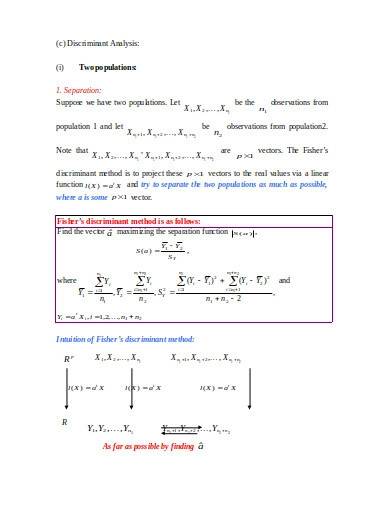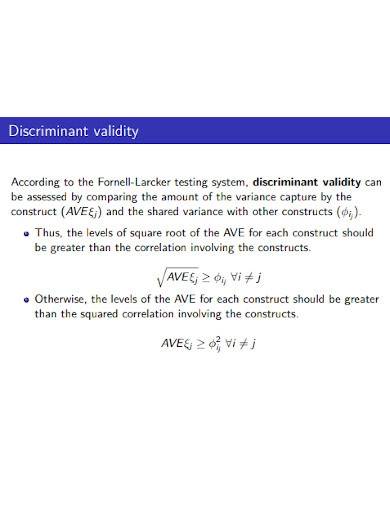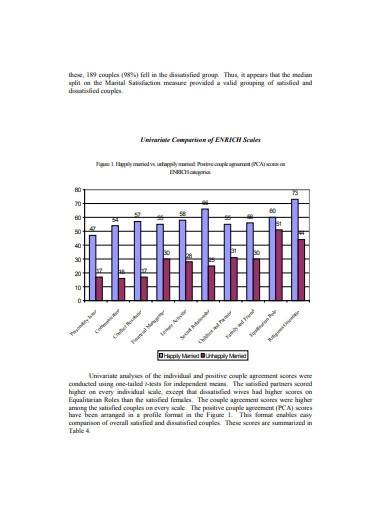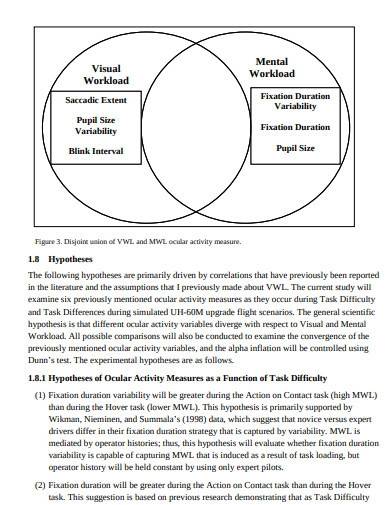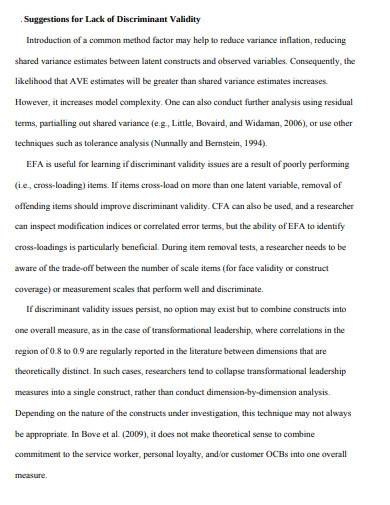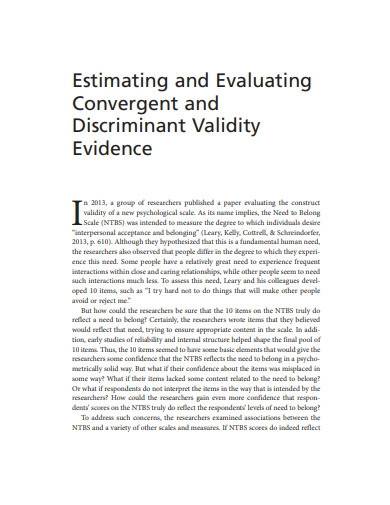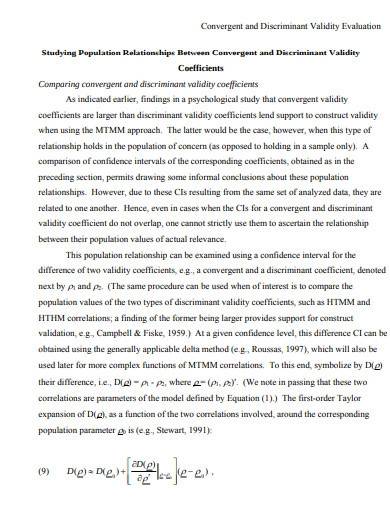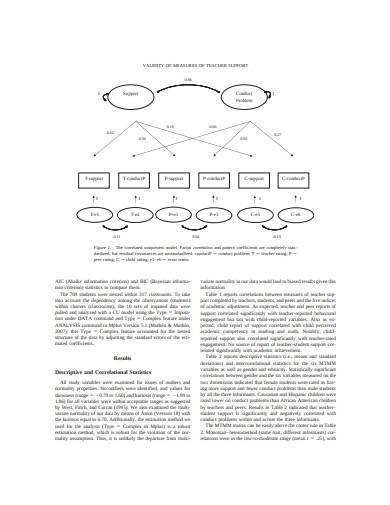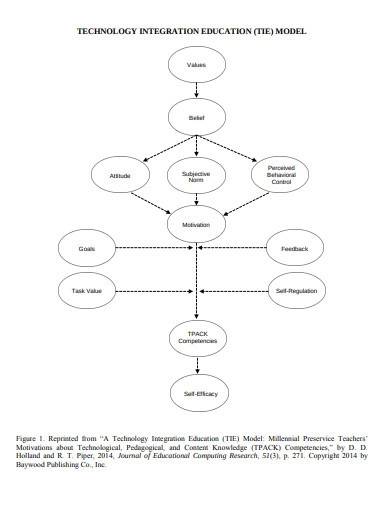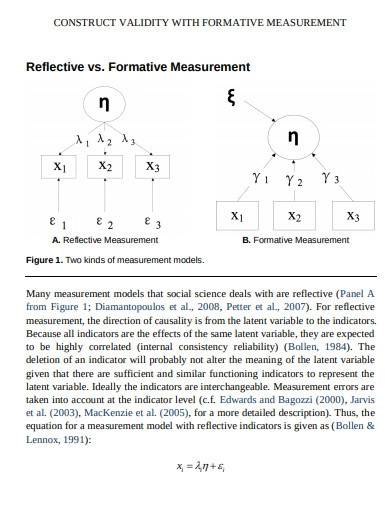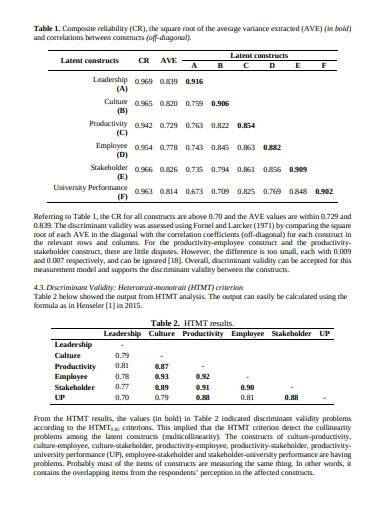In research, there are different constructs that researchers are interested in measuring. For example, in a study on the relationship between job application satisfaction and turnover report intentions, the researchers would want to ensure that their measures of job satisfaction and turnover intentions are distinct from one another. Discriminant validity helps ensure that the measures of different constructs are not measuring the same underlying factor, which can lead to spurious findings.
FREE 10+ Discriminant Validity Samples & Templates in MS Word | PDF
1. Discriminant Validity Analysis Template
2. Discriminant Validity Template
3. Discriminant Validity and Cross Validity
4. Convergent and Discriminant Validity
5. Sample Discriminant Validity Template
6. Sample Convergent & Discriminant Validity
7. Convergent and Discriminant Validity Evaluation
8. Discriminant Validity of Child Template
9. Simple Convergent and Discriminant Validity
10. Standard Discriminant Validity Template
11. Discriminant Validity Assessment Template
What is Discriminant Validity?
Discriminant validity is a fundamental concept in research methodology that is used to assess the degree to which measures of different constructs are distinct from one another. It is a crucial aspect of action research, especially in social sciences and psychology case study, as it ensures that a measure is not simply measuring something else.
How To Make Discriminant Validity?
One of the most common methods for assessing discriminant validity is confirmatory factor analysis (CFA). CFA is a statistical technique that examines the extent to which measures of different constructs load onto different factors. To ensure that your measures have adequate discriminant validity, there are several steps you can take:
Step 1- Develop a theoretical framework
Before measuring any constructs, it is important to develop a theoretical framework that specifies the relationships among the constructs. This framework should clearly define the constructs of interest and their expected relationships with one another.
Step 2- Choose appropriate measures
Choose measures that are widely accepted and have been validated in previous research. If you are developing new measures, ensure that they are grounded in the theoretical framework and that their items are unambiguously related to the constructs of interest.
Step 3- Collect data
Collect research data collection form from participants using the chosen measures. Make sure to collect enough data to allow for robust statistical analysis.
Step 4- Analyze the data
Use statistical techniques such as confirmatory factor analysis to assess the discriminant validity of the measures. In CFA, you will specify a model that represents the theoretical framework and test it against the data. The model should show that the measures of each construct are more closely related to their own construct than to any other constructs.
How is discriminant validity assessed?
Discriminant validity is typically assessed through statistical techniques such as confirmatory factor analysis (CFA), multitrait-multimethod analysis, and the use of convergent and discriminant validity coefficients. These techniques examine the extent to which measures of different constructs load onto different factors or are distinct from one another.
What are some strategies for ensuring discriminant validity?
Strategies for ensuring discriminant validity include developing a theoretical framework, choosing appropriate measures, collecting adequate data, using appropriate statistical techniques, interpreting the survey result report, and reporting the findings clearly.
What happens if measures do not have adequate discriminant validity?
If measures do not have adequate discriminant validity, researchers may need to revise the measures or the theoretical framework to better reflect the distinctions between the constructs. It may also be necessary to collect additional data or use different statistical techniques to better assess discriminant validity.
Overall, discriminant validity is a crucial aspect of research methodology. It ensures that the measures of different constructs are distinct from one another and that the findings are not based on spurious relationships. By using methods such as CFA and other statistical techniques, researchers can ensure that their measures have adequate discriminant validity, which is essential for drawing valid essay conclusions and making meaningful research contribution statement to the field.
Related Posts
FREE 10+ Construct Validity Samples & Templates in MS Word | PDF
FREE 10+ Code of Human Research Ethics Samples & Templates in MS Word | PDF
FREE 10+ Biography Research Report Samples and Templates in PDF
FREE 10+ System Documentation Samples & Templates in MS Word | PDF
FREE 10+ Process Document Samples & Templates in MS Word | PDF
FREE 10+ Action Research Samples & Templates in PDF
FREE 10+ Longitudinal Research Samples & Templates in PDF | MS Word
FREE 10+ Causal Research Samples & Templates in MS Word | PDF
FREE 10+ Client Discovery Samples & Templates in MS Word | PDF
FREE 10+ Null Hypothesis Samples & Templates in MS Word | PDF
FREE 9+ Product Knowledge Samples & Templates in PDF
FREE 10+ Software Documentation Samples & Templates in MS Word | PDF
FREE 10+ Exploratory Research Samples & Templates in PDF | MS Word
FREE 10+ Experimental Research Samples & Templates in MS Word | PDF
FREE 10+ Descriptive Research Samples & Templates in PDF

